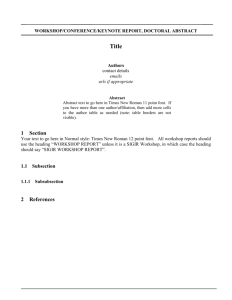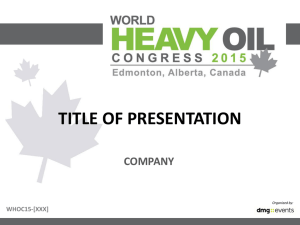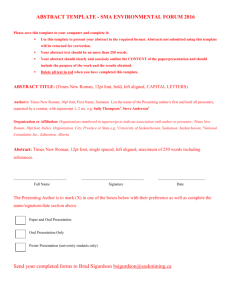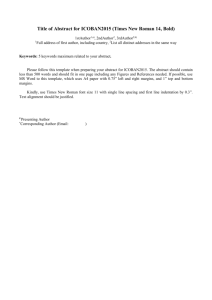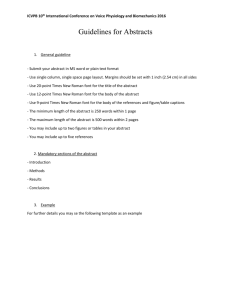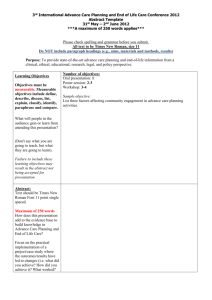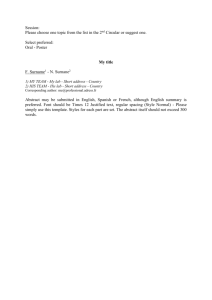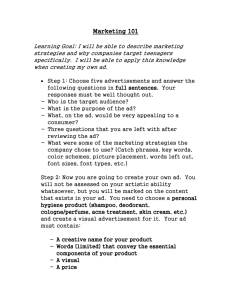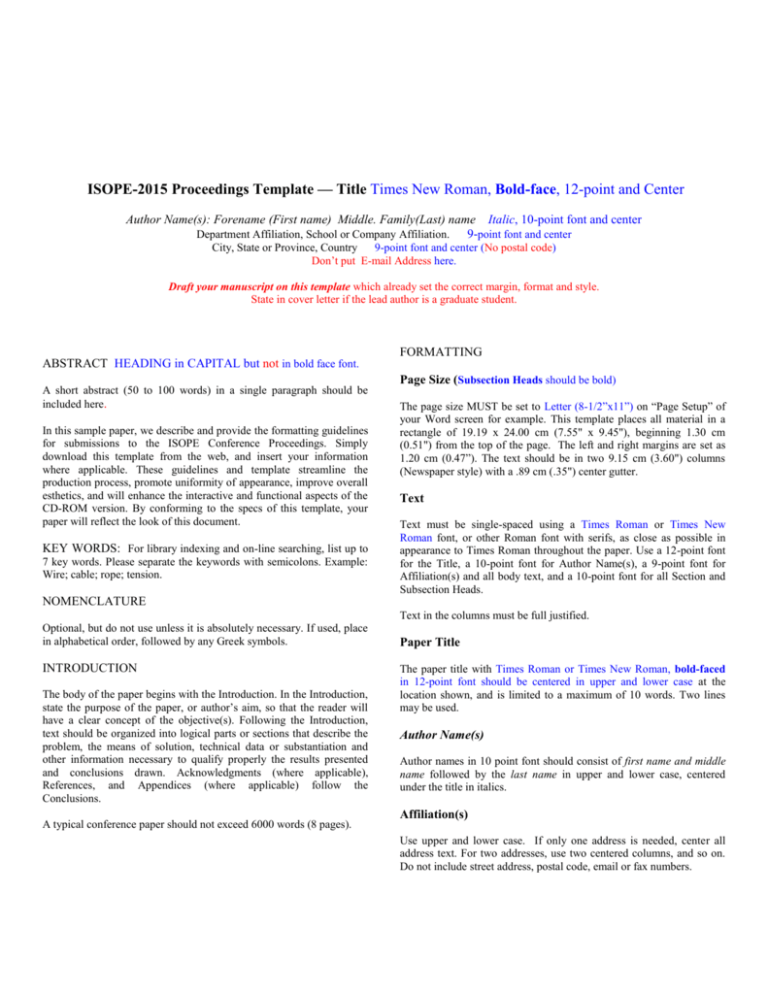
ISOPE-2015 Proceedings Template — Title Times New Roman, Bold-face, 12-point and Center
Author Name(s): Forename (First name) Middle. Family(Last) name Italic, 10-point font and center
Department Affiliation, School or Company Affiliation.
9-point font and center
City, State or Province, Country
9-point font and center (No postal code)
Don’t put E-mail Address here.
Draft your manuscript on this template which already set the correct margin, format and style.
State in cover letter if the lead author is a graduate student.
ABSTRACT HEADING in CAPITAL but not in bold face font.
A short abstract (50 to 100 words) in a single paragraph should be
included here.
In this sample paper, we describe and provide the formatting guidelines
for submissions to the ISOPE Conference Proceedings. Simply
download this template from the web, and insert your information
where applicable. These guidelines and template streamline the
production process, promote uniformity of appearance, improve overall
esthetics, and will enhance the interactive and functional aspects of the
CD-ROM version. By conforming to the specs of this template, your
paper will reflect the look of this document.
KEY WORDS: For library indexing and on-line searching, list up to
7 key words. Please separate the keywords with semicolons. Example:
Wire; cable; rope; tension.
FORMATTING
Page Size (Subsection Heads should be bold)
The page size MUST be set to Letter (8-1/2”x11”) on “Page Setup” of
your Word screen for example. This template places all material in a
rectangle of 19.19 x 24.00 cm (7.55" x 9.45"), beginning 1.30 cm
(0.51") from the top of the page. The left and right margins are set as
1.20 cm (0.47”). The text should be in two 9.15 cm (3.60") columns
(Newspaper style) with a .89 cm (.35") center gutter.
Text
Text must be single-spaced using a Times Roman or Times New
Roman font, or other Roman font with serifs, as close as possible in
appearance to Times Roman throughout the paper. Use a 12-point font
for the Title, a 10-point font for Author Name(s), a 9-point font for
Affiliation(s) and all body text, and a 10-point font for all Section and
Subsection Heads.
NOMENCLATURE
Text in the columns must be full justified.
Optional, but do not use unless it is absolutely necessary. If used, place
in alphabetical order, followed by any Greek symbols.
INTRODUCTION
The body of the paper begins with the Introduction. In the Introduction,
state the purpose of the paper, or author’s aim, so that the reader will
have a clear concept of the objective(s). Following the Introduction,
text should be organized into logical parts or sections that describe the
problem, the means of solution, technical data or substantiation and
other information necessary to qualify properly the results presented
and conclusions drawn. Acknowledgments (where applicable),
References, and Appendices (where applicable) follow the
Conclusions.
A typical conference paper should not exceed 6000 words (8 pages).
Paper Title
The paper title with Times Roman or Times New Roman, bold-faced
in 12-point font should be centered in upper and lower case at the
location shown, and is limited to a maximum of 10 words. Two lines
may be used.
Author Name(s)
Author names in 10 point font should consist of first name and middle
name followed by the last name in upper and lower case, centered
under the title in italics.
Affiliation(s)
Use upper and lower case. If only one address is needed, center all
address text. For two addresses, use two centered columns, and so on.
Do not include street address, postal code, email or fax numbers.
SECTION and Subsection Heads
Headings and subheadings appear throughout the text to divide the
subject matter into logical parts and emphasize major elements and
considerations. Do not number them.
Equations should be left-justified. Enclose equation numbers in
parentheses and place flush right with right-hand margin of the column.
F ( x, y, z; t ) Ax x 2 B y y 3 Cz exp k x x t
(1)
SECTION HEADS should be flush left in all UPPER case (CAPITAL
letters).
Figures
Subsection Heads should be bold and flush left in upper and lower
case as shown. For subsection heads, a word like the or a is not
capitalized unless it is the first word of the header.
Number figures consecutively and use the figure number when
referring to a figure (Fig. 1) or figures (Figs. 2~3), ... Figures must have
a caption consisting of an abbreviated number, like Fig. 1, and brief
title and should be placed below figure, left-justified.
Sub-subsection heads. Sub-subsection heads should be treated as a
bold paragraph lead-in. Sub-subsection heads should be 9-point, BoldItalic, upper and lower case and the paragraph full justified.
For good legibility, lines, letters and symbols must be of sufficient
weight (or darkness), size and thickness. Avoid using shades.
Text Citation of References
Within text of an article, references are to be cited by last name of
author(s) and year of publication. Each reference to include last names of
all authors. For example:
.....was discovered (Longuet-Higgins and Fox, 1977)
Ueda and Rashed (1990) proposed …
Sparrow (1980a) discovered .....
It was also noted (Graebel, 2007; Kim, 2008; Sparrow, 1980b; Kheisin,
1992) that .....
Place Figures/Images in text as close to the reference as possible.
Figures may extend across both columns to a maximum width of 19.19
cm (7.55”); however, figures preferably should fit within columns to
minimize unused space.
Note: Only if your PDF file is converted correctly will your PDF
electronic submission be used for the CD-ROM version of the
proceedings. Be aware that, as a general rule, graphics in the printed
version will be depicted in black and white. On the CD-ROM, however,
the graphics will be portrayed in color wherever possible. Please be
aware of the quality of your figures, illustrations, and photos.
Figures that are line-art should be scanned at 600 dpi, whereas screened
figures should be scanned as grayscale at 300 dpi.
Last Page
The two columns on the last page should be as close to equal length as
possible.
Length
Please scan photos at 300 dpi, use the grayscale setting on your
scanner, and place photo into position on your electronic document.
Footnotes
Typical conference paper should not exceed 8 template pages including
illustrations).
Tables
Optional, but do not use unless it is absolutely necessary. Footnotes
should be 9-point and justified to the full width of the column.
CONCLUSIONS
It is often advantageous to place information in a tabular format as
shown here. Number tables consecutively and use table numbers when
referring to a table (Table 1, Tables 2~3,...).
A brief summary of your research results should be included in this
section toward the end of the paper.
Table 1. Table captions should be placed above table, left-justified
ACKNOWLEDGEMENTS
Margins
Left Column
Right Column
Top
0.51 in (1.3 cm)
0.51 in (1.3 cm )
Left
0.47 in (1.2 cm)
4.42 in (11.24 cm)
Right
4.07 in (10.35 cm)
8.02 in (20.39 cm)
Bottom
9.96 in (25.3 cm)
9.96 in (25.3 cm)*
*The use of SI Units must be used for all weights and measures. If
other units are used, the equivalent SI Unit should be included as
shown above. Give a space between number and unit; e.g. 1.3 cm.
Equations
Equations are to be numbered consecutively from Eq. 1 to the end of
the paper including any appendices. Use the equation number when
referring to equations (Eq. 1, Eqs. 5~7,...). Please take care to type
equations accurately.
Acknowledgements may be made to those individuals or institutions
not mentioned elsewhere in the paper that made an important
contribution.
REFERENCES
References to original (not secondary) sources for cited material is to
be listed together at the end of the paper and should be justified ragged
right. References should be published materials (excluding computer
program manuals) accessible to the public. Internal technical reports
may be cited only if they are easily accessible to the public or any
reader. Private communications should be acknowledged within text,
not referenced (e.g., “[Coyle, personal communication]”).
List of References shall be arranged in alphabetical order of family name
of the first- author for articles with more than one author. Do not number
them. Titles of books, periodicals and conference proceedings to be in
italics.
Examples (new style) are:
Dias, F, Ghidaglia, J-M, and Le Coq, G (2007). “On the Fluid Dynamics
Models for Sloshing,” Proc 17th Int Offshore and Polar Eng Conf,
Lisbon, ISOPE, 3, 1880–1888.
Graebel, WP (2007). Advanced Fluid Mechanics, Academic Press, 362.
Kheisin, DE (1992). "Dynamics of Ice Cover Interacting with Ocean and
Atmosphere," Int J Offshore and Polar Eng, ISOPE, 3(1), 43-50.
Kim, CH (2008). Nonlinear Waves and Offshore Structures, World
Scientific, 516.
Longuet-Higgins, MS, and Fox, MJH (1977). "Theory of the Almost
Highest Wave: the Inner Solution," J Fluid Mech, 80, 721-41.
Sparrow, EM (1980a). "Parallel Processing ...,"
Sparrow, EM (1980b). "Forced-Convection Heat Transfer ...
Protuberances," Num Heat Transfer, 12(2), 149-167.
Ueda, Y, and Rashed, SMH (1990). "Modern Method of ... Offshore
Structures," Proc 1st Pacific/Asia Offshore Mech Symp, Seoul, ISOPE,
3, 315-328.
E-mail your manuscript for review in WORD file, after the file
attachment(s) is made less than 5 MB after ZIP.
You may also submit a LaTeX file accompanied by a corresponding
PDF file.
Figure quality. The printer requires the figure file quality 1MB in
file size or in vector format.
FINAL MANUSCRIPT (MS) SUBMISSION AND PDF
MAKING INSTRUCTIONS
The ISOPE will issue a letter and instructions in time to the
corresponding authors on what to send where. This includes specific
information of how to create high CD-ROM quality PDF file.
APPENDIXES
In a highly mathematical paper it is advisable to develop equations
and formulas in an appendix. Appendixes also may be used for
detailed descriptions of apparatus and other related material not
essential to general presentation of subject.
MANUSCRIPT FOR REVIEW
Copyright ©2015 The International Society of Offshore and Polar
Engineers (ISOPE). All rights reserved.
\Conf-std\Template-Word-MS-2015 (1006-2014

